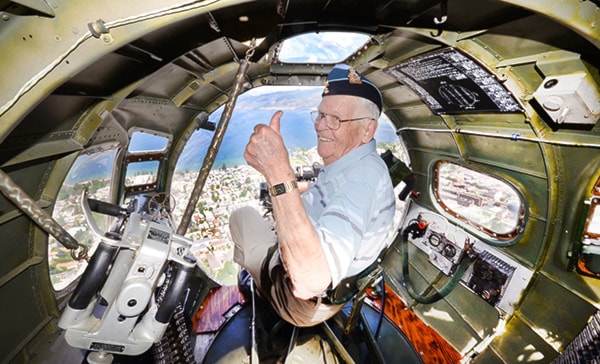Tapping on the Plexiglas of the B-17G bomber’s nose turret and pointing to the city below, my 92-year-old co-passenger turns with a big smile and gives the thumbs up.
Back on the ground, still belted into his front row seat, Bob Anderson, who flew Wellington aircraft for the RAF in the Second World War was overcome with emotion.
“This, this really brings back a lot of memories, mostly good ones but some not so good,” he said, his lips quivering and tears in his eyes. “I had forgotten what is was like, but this has brought everything back, this was a thrill, this was a terrific ride.”
His opportunity for the flight on the vintage aircraft nicknamed Sentimental Journey actually came out of the blue after he received the invitation just hours earlier.
Organized by the Penticton Flying Club, the aircraft is here until Aug. 2 as part of the Commemorative Air Force (Airbase Arizona) tour through Western Canada.
While at the airport the public will have an opportunity from 9 a.m. to 6 p.m. to tour the plane and talk to crew. Flights can also be purchased.
The first aerial sojourn following its arrival was for media and special guests who had the “gumption” to take the 15-minute ride west along the Lake Okanagan shoreline, returning on the east side with a landing approach over the sparkling waters of Skaha.
“This was the best seat in the house and I wouldn’t have missed it for the world,” said Anderson, whose agility as he extricated himself from the confined space belied his years. “I wasn’t worried at all, it was just so terrific to see everything from this angle. It was a thrill of a lifetime.”
Those were strong words of praise, especially coming from someone who had over 800 hours flying the twin-engine Vickers Wellington bomber, mainly on anti-submarine runs in the Second World War.
“I’ll tell you flying 50 feet off the water and dropping torpedoes is not fun,” he said.
With four engines, and able to carry a large payload of bombs as well as plenty of fire power from machine guns in eight positions on the plane, the B-17 was dubbed the Flying Fortress.
At the flight controls this day was Russ Gilmore a retired airline pilot who currently flies large C 130 aircraft on missions relating to oil spills.
When asked why he volunteered his time and skills and the importance of keeping the aircraft flying, he replied: “A typical mission for this airplane would be 25,000 to 30,000 feet, 50 degrees (Fahrenheit) below zero, 10-hour missions, half the crew would go to the infirmary with some kind of frost bite usually on their face any place there was exposed skin.
“That was the least of their problems because the Germans were pretty good shots and so were the Japanese and so we’re never going to forget the heroism and sacrifices our veterans made then and now for the freedoms we enjoy and that’s why we do what we do.”
And for veteran Bob Anderson, this was truly a sentimental journey.
